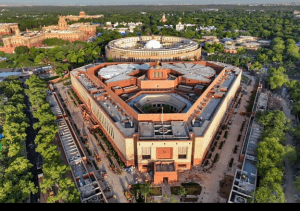The Parliament of India is the supreme legislative body that embodies the democratic ethos of the country. Located in New Delhi, this iconic building not only serves as the heart of Indian democracy but also stands as a testament to the nation’s rich architectural heritage. Let us delve into the history, design, significance, and recent developments of this monumental structure.
1. History and Evolution of the Parliament Building
The Indian Parliament building was conceptualized during British rule and designed by renowned British architects Edwin Lutyens and Herbert Baker. Construction began in 1921 and was completed in 1927, taking six years to build. Initially called the Council House, it housed the Imperial Legislative Council during the British era.
After independence, the building became the venue for the Indian Parliament, symbolizing the nation’s transition to a democratic republic.
Key Features of the Original Building:
- Shape: A circular structure inspired by the Chausath Yogini temple in Madhya Pradesh.
- Diameter: 170 meters, with a total area of 6 acres.
- Architecture: A blend of Indian and European styles with colonnades, arches, and intricate carvings.
- Cost: Approximately ₹83 lakh in 1927.
2. Architectural Design
The Parliament building comprises three main chambers:
- The Lok Sabha (House of the People).
- The Rajya Sabha (Council of States).
- The Central Hall, where joint sessions and important events are held.
The structure is surrounded by lush gardens and has a perimeter of 533 meters. Its design includes Ashokan motifs, stone latticework (jalis), and intricate detailing that reflects India’s cultural diversity.
3. The New Parliament Building: A Vision for the Future
In 2020, the Indian government initiated the construction of a new Parliament building under the Central Vista Redevelopment Project to accommodate modern needs and reflect India’s growing stature globally. The new building was inaugurated on May 28, 2023, by Prime Minister Narendra Modi.
Features of the New Parliament Building:
- Design: Triangular structure representing India’s trinity philosophy (creation, preservation, and destruction).
- Size: 64,500 square meters, larger and more technologically advanced than the old building.
- Seating Capacity:
- Lok Sabha: 888 members (expandable to 1,272).
- Rajya Sabha: 384 members.
- Eco-Friendly: Built with sustainable materials and equipped with modern green technologies.
- Cost: Approximately ₹971 crore.
Highlights:
- The building houses a Constitution Hall, showcasing a copy of the Indian Constitution.
- Incorporates state-of-the-art audio-visual systems and digital facilities.
- Inspired by India’s cultural ethos, with murals, sculptures, and artwork from across the country.
Learn more about the New Parliament Building from the official government site.
4. Significance of the Parliament Building
The Parliament symbolizes:
- Democracy: The process of policymaking and governance.
- Heritage: The seamless blend of historical and modern architecture.
- Unity in Diversity: Representation of all states and union territories.
The old and new buildings collectively embody India’s journey from colonial rule to a modern, independent democracy.
5. Visitor Information
How to Visit the Parliament Building
- Timings: Open for guided tours on select days (check official schedules).
- Entry Fee: Nominal charges for Indian citizens and foreigners.
- Security: Strict protocols; ID proof required.
- Booking: Visit the Parliament Museum and Tours Website.
Nearby Attractions:
- India Gate (1.5 km away).
- Rashtrapati Bhavan (2 km away).
- National Museum (3 km away).
6. Fun Facts About the Parliament Building
- The Central Hall is where the transfer of power ceremony took place on August 15, 1947.
- The Ashokan pillars and motifs in the old building emphasize India’s ancient heritage.
- The new building is the largest parliamentary building in the world.
7. Conclusion
The Parliament building of India, in both its old and new avatars, stands as a symbol of India’s democratic values, architectural brilliance, and cultural heritage. As a hub of policymaking and governance, it reflects the aspirations and unity of over a billion people.
Explore the Parliament Building and witness the marvel of Indian democracy in action!
For more detailed information, visit the Parliament of India’s Official Website.
Chirag Singh is a content writer with a focus on real estate, covering topics like News, Guidance, Tips, Property trends and Investments. He has written for various platforms, providing helpful insights to readers. With a background in real estate, Chirag combines his knowledge and passion for real estate in his work. He enjoys staying updated on the latest industry trends.

